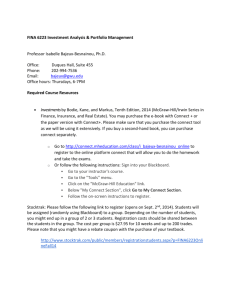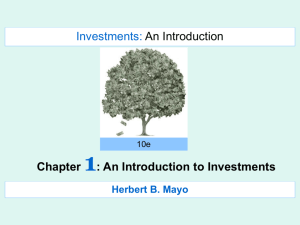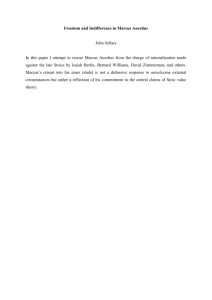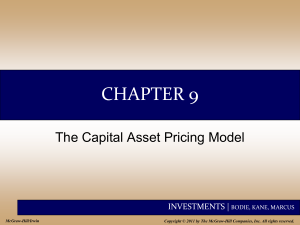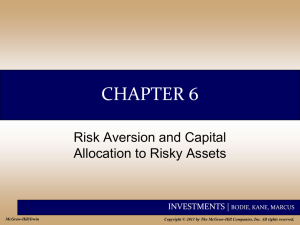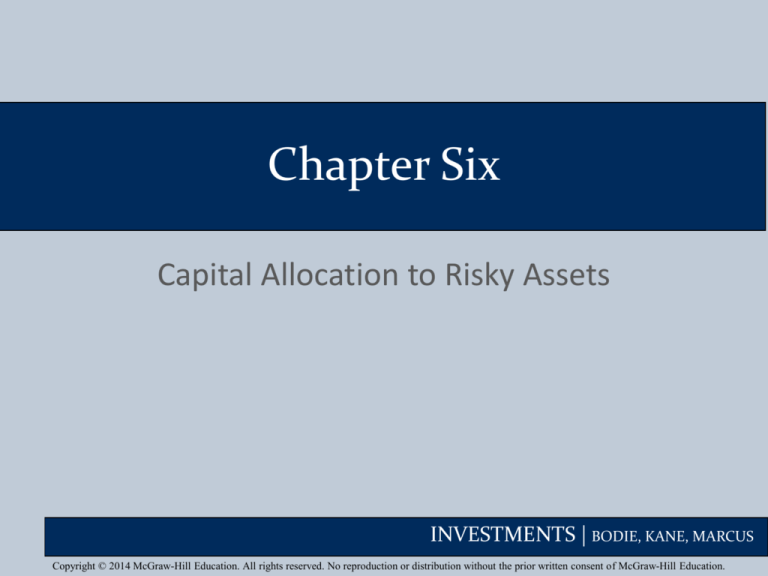
Chapter Six
Capital Allocation to Risky Assets
INVESTMENTS | BODIE, KANE, MARCUS
Copyright © 2014 McGraw-Hill Education. All rights reserved. No reproduction or distribution without the prior written consent of McGraw-Hill Education.
Chapter Overview
• Risk aversion and its estimation
• Two-step process of portfolio construction
• Composition of risky portfolio
• Capital allocation between risky and risk-free
assets
• Passive strategies and the capital market line
(CML)
6-2
INVESTMENTS | BODIE, KANE, MARCUS
Risk and Risk Aversion
Speculation
Gamble
• Taking considerable risk
for a commensurate
gain
• Bet on an uncertain
outcome for enjoyment
• Parties have
heterogeneous
expectations
6-3
• Parties assign the
same probabilities to
the possible outcomes
INVESTMENTS | BODIE, KANE, MARCUS
Risk and Risk Aversion
• Utility Values
• Investors are willing to consider:
• Risk-free assets
• Speculative positions with positive risk
premiums
• Portfolio attractiveness increases with expected
return and decreases with risk
• What happens when return increases with risk?
6-4
INVESTMENTS | BODIE, KANE, MARCUS
Table 6.1 Available Risky Portfolios
Each portfolio receives a utility score to assess
the investor’s risk/return trade off
6-5
INVESTMENTS | BODIE, KANE, MARCUS
Risk Aversion and Utility Values
• Utility Function
•
•
•
•
•
U = Utility
E(r) = Expected return on the asset or portfolio
A = Coefficient of risk aversion
σ2 = Variance of returns
½ = A scaling factor
2
1
U E r
A
2
6-6
INVESTMENTS | BODIE, KANE, MARCUS
Table 6.2 Utility Scores of Portfolios with
Varying Degrees of Risk Aversion
6-7
INVESTMENTS | BODIE, KANE, MARCUS
Estimating Risk Aversion
• Use questionnaires
• Observe individuals’ decisions when
confronted with risk
• Observe how much people are willing to pay
to avoid risk
6-8
INVESTMENTS | BODIE, KANE, MARCUS
Estimating Risk Aversion
• Mean-Variance (M-V) Criterion
• Portfolio A dominates portfolio B if:
ErA ErB
and
A B
6-9
INVESTMENTS | BODIE, KANE, MARCUS
Capital Allocation Across Risky
and Risk-Free Portfolios
• Asset Allocation
• The choice among broad asset classes that
represents a very important part of portfolio
construction
• The simplest way to control risk is to
manipulate the fraction of the portfolio
invested in risk-free assets versus the portion
invested in the risky assets
6-10
INVESTMENTS | BODIE, KANE, MARCUS
Basic Asset Allocation Example
Total market value
Risk-free money market fund
$300,000
$90,000
Equities
Bonds (long-term)
Total risk assets
$113,400
$96,600
$210,000
$113,400
WE
0.54
$210,000
6-11
$96,600
WB
0.46
$210,00
INVESTMENTS | BODIE, KANE, MARCUS
Basic Asset Allocation Example
Let
• y = Weight of the risky portfolio, P, in the complete
portfolio
• (1-y) = Weight of risk-free assets
$210,000
y
0.7
$300,000
$113,400
E:
.378
$300,000
6-12
$90,000
1 y
0.3
$300,000
$96,600
B:
.322
$300,000
INVESTMENTS | BODIE, KANE, MARCUS
The Risk-Free Asset
• Only the government can issue default-free
securities
• A security is risk-free in real terms only if its price
is indexed and maturity is equal to investor’s
holding period
• T-bills viewed as “the” risk-free asset
• Money market funds also considered risk-free
in practice
6-13
INVESTMENTS | BODIE, KANE, MARCUS
Figure 6.3 Spread Between 3-Month
CD and T-bill Rates
6-14
INVESTMENTS | BODIE, KANE, MARCUS
Portfolios of One Risky Asset and a
Risk-Free Asset
• It’s possible to create a complete portfolio by
splitting investment funds between safe and
risky assets
• Let
• y = Portion allocated to the risky portfolio, P
• (1 - y) = Portion to be invested in risk-free asset, F
6-15
INVESTMENTS | BODIE, KANE, MARCUS
One Risky Asset and a Risk-Free
Asset: Example
rf = 7%
E(rp) = 15%
rf = 0%
p = 22%
• The expected return on the complete portfolio:
E rc 7 y15 7
• The risk of the complete portfolio:
C y P 22 y
6-16
INVESTMENTS | BODIE, KANE, MARCUS
One Risky Asset and a Risk-Free
Asset: Example
• Rearrange and substitute y = σC/σP:
C
8
E rC rf
E rP rf 7 C
P
22
Slope
6-17
E rP rf
P
8
22
INVESTMENTS | BODIE, KANE, MARCUS
Figure 6.4 The Investment Opportunity Set
6-18
INVESTMENTS | BODIE, KANE, MARCUS
Portfolios of One Risky Asset and a
Risk-Free Asset
• Capital allocation line with leverage
• Lend at rf = 7% and borrow at rf = 9%
• Lending range slope = 8/22 = 0.36
• Borrowing range slope = 6/22 = 0.27
• CAL kinks at P
6-19
INVESTMENTS | BODIE, KANE, MARCUS
Figure 6.5 The Opportunity Set with
Differential Borrowing and Lending Rates
6-20
INVESTMENTS | BODIE, KANE, MARCUS
Risk Tolerance and Asset Allocation
• The investor must choose one optimal
portfolio, C, from the set of feasible choices
• Expected return of the complete portfolio:
E rc r f y E rp r f
• Variance:
y
2
c
6-21
2
2
p
INVESTMENTS | BODIE, KANE, MARCUS
Table 6.4 Utility Levels for
Various Positions in Risky Assets
6-22
INVESTMENTS | BODIE, KANE, MARCUS
Figure 6.6 Utility as a Function of
Allocation to the Risky Asset, y
6-23
INVESTMENTS | BODIE, KANE, MARCUS
Table 6.5 Spreadsheet Calculations
of Indifference Curves
6-24
INVESTMENTS | BODIE, KANE, MARCUS
Figure 6.7 Indifference Curves for
U = .05 and U = .09 with A = 2 and A = 4
6-25
INVESTMENTS | BODIE, KANE, MARCUS
Figure 6.8 Finding the
Optimal Complete Portfolio
6-26
INVESTMENTS | BODIE, KANE, MARCUS
Table 6.6 Expected Returns on Four
Indifference Curves and the CAL
6-27
INVESTMENTS | BODIE, KANE, MARCUS
Passive Strategies:
The Capital Market Line
• The passive strategy avoids any direct or
indirect security analysis
• Supply and demand forces may make such a
strategy a reasonable choice for many
investors
• A natural candidate for a passively held risky
asset would be a well-diversified portfolio of
common stocks such as the S&P 500
6-28
INVESTMENTS | BODIE, KANE, MARCUS
Passive Strategies:
The Capital Market Line
• The Capital Market Line (CML)
• Is a capital allocation line formed investment in
two passive portfolios:
1. Virtually risk-free short-term T-bills (or a
money market fund)
2. Fund of common stocks that mimics a broad
market index
6-29
INVESTMENTS | BODIE, KANE, MARCUS
Passive Strategies:
The Capital Market Line
• From 1926 to 2012, the passive risky portfolio
offered an average risk premium of 8.1% with
a standard deviation of 20.48%, resulting in a
reward-to-volatility ratio of .40
6-30
INVESTMENTS | BODIE, KANE, MARCUS


